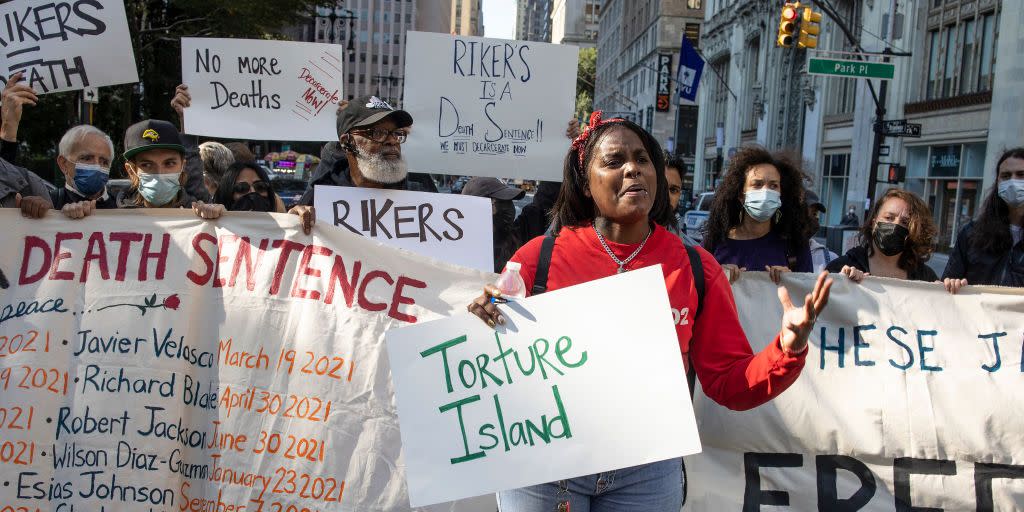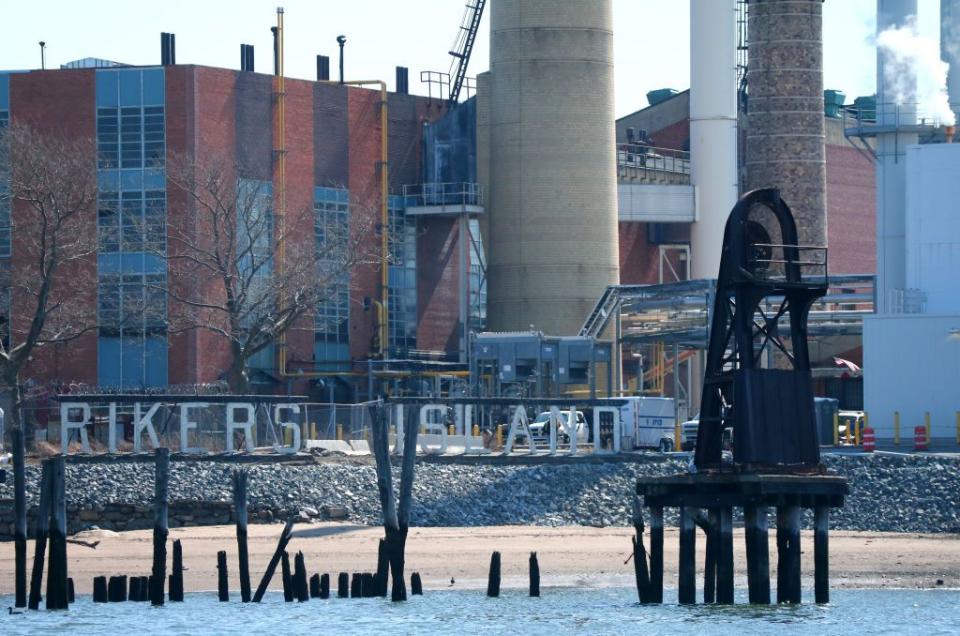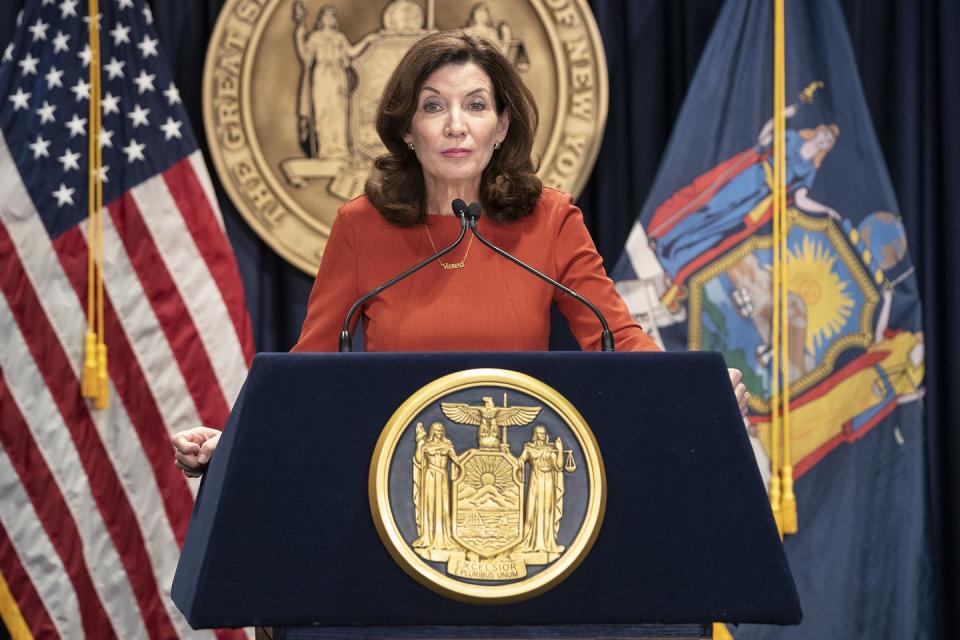What Is Happening With Rikers Right Now? Here's Everything You Need to Know.

- Oops!Something went wrong.Please try again later.
- Oops!Something went wrong.Please try again later.
Hearings, protests, rallies, lawsuits, committee updates, commissions findings, dozens of new interviews, and too many press statements to count; for those involved in dealing with the humanitarian crisis known as Rikers Island, it’s been another sleepless week.
On Thursday, Department of Corrections Officer Vincent Schiraldi announced the hiring of former NYPD Chief of Operations Raymond Spinella. According to the New York Daily News, Spinella has been brought on “to bring sanity” to the beleaguered prison. The announcement followed a protest on Wednesday outside the offices of Manhattan District Attorney Cyrus Vance. “Free them all!” read one sign. “Rikers=death” read another.

What is Rikers Island?
Rikers Island is a New York City jail complex, the second largest in the country behind Los Angeles County Jail, located on an island in the East River. It is only accessible via a bridge that connects the island to a section of Queens near LaGuardia airport.
There are currently nearly 6,000 individuals detained on Rikers. Notably, the vast majority of them are pre-trial detainees, meaning they are awaiting trial and have not been convicted of any crimes. Despite being presumed innocent by the Constitution, these inmates are held in Rikers because they were unable to post the bail issued to them by a local judge during their arraignment. This is partly why people say, “the poor stay in jail, while the rich go free.”
In 2019, the New York City Council approved Mayor Bill DeBlasio’s proposal to close Rikers and replace it with four smaller jails, one in each borough except Staten Island, by 2026, but so far things aren’t going according to plan.
What triggered the renewed protests and call for reforms?
Rikers Island has always been notorious for its brutal conditions, but in August the situation spun out of control amidst a soaring detainee population and a staffing shortage. The combination of the two factors brought the flow of traffic within Rikers to a grinding halt, which in turn led to a gross downturn in the complex’s already inhumane living conditions and dysfunctional handling of essential services like medical care and inmate safety. There have been multiple reports of detainees going without food, water, toilets and showers. In September, the crisis attracted widespread public outrage when another person—the 12th this year—died in city jail custody. Five detainees reportedly died by suicide after corrections officers failed to enact suicide prevention measures installed earlier this year.
In a feature in The Marshall Project, inmates described the scene at Rikers in disturbing, cinematic detail. “It looks like a slave ship in there,” said a detainee named Jeffrey about the intake area where inmates are first held before being sorted to a separate living complex. “There were like 30 of us piled in there.” Inmates aren’t supposed to be in the intake area, nicknamed the bullpen, for more than 24 hours. Jeffrey was there for five days.

What have lawmakers done?
There has always been talk of dismantling Rikers, but the most recent crisis has brought conversations to a fever pitch. Even New York Attorney General Letitia James said the latest events were a “breaking point.”
Indeed, New York Governor Kathy Hochul has already taken more steps to reform Rikers in the past two weeks than Mayor DeBlasio had taken in the four years that have passed since he declared Rikers would shut down in 2027, long after he has left office. On September 17th, Gov. Hochul signed the Less Is More Act, which ends incarceration for most minor non-criminal offenses. Crucially, it also stops people being accused of violating the often burdensome and mundane technical conditions of their parole from being automatically thrown back in jail.
Gov. Hochul also ordered the immediate release of 191 inmates and the transfer of 200 more to other facilities, and the state of emergency she declared will accelerate casework and sentencing (thereby reducing Riker’s overwhelming pre-trial population, so the logic goes) by allowing remote court hearings to continue.
Within New York City, Manhattan District Attorney Cy Vance used his powers to suspend bail for certain low-level crimes, but critics have questioned his commitment to the suspension. And after visiting Rikers for the first time in four years, Mayor Bill DeBlasio enacted a handful of emergency decrees intended to crack down on corrections officers absenteeism, expand medical evaluation capacity, speed up the prisoner intake process, and fix urgent repairs to Riker’s crumbling and dangerous infrastructure.
What might happen next?
To de-escalate the crisis at Rikers in the short-term, criminal justice advocates say more must be done. Many elected officials agree. That is why they have introduced additional legislation like the Treatment Not Jails Act which would move inmates with substantial mental health needs into treatment facilities. But significant legislation like the Treatment Not Jails Act cannot be voted on until the state legislature meets again, and that’s not scheduled to happen until early 2022.
In the meantime, experts say the most effective remedy would be to stop sending so many people to jail. It’s deceptively simple sounding isn’t it? Except doing so would require buy-in from a group of people who so far seem unwilling to cooperate: New York City judges. A remarkable study put together by New York Focus reveals that judges are detaining an increasing number of people before their trials, despite the excruciating conditions they face at Rikers. Another effective option would be for district attorneys to stop seeking unaffordable bail for people who are not at flight risk, but calls for them to do so have, so far, gone unheeded.
Despite all the unknowns, what is clear is that Rikers’ return to the spotlight has provided the criminal justice reform movement with some much needed momentum. Mayor DeBlasio’s plan to shut Rikers down in 2027 is already delayed and unlikely to proceed. Even if it was tenable, many elected state officials say the prison’s shuttering cannot wait another six years. There are good alternative plans on the table but swift and decisive action must be taken for them to make a difference. Meanwhile, the protests continue. Another rally is scheduled for Tuesday, October 12th outside City Hall.
You Might Also Like

